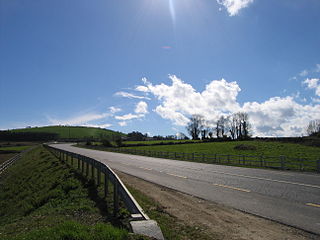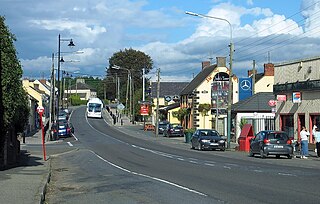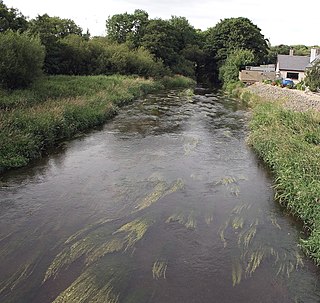Related Research Articles
Camolin, according to a 2004 report in the German magazine Der Spiegel, is a secret counter-terrorism unit based in Paris, France. The article states that the US, UK, Australia, Germany, and France - amongst others - created this unit after the 11 September 2001 attacks on the US. Started as Alliance Base in 2002, the unit is now codenamed Camolin.

John Murphy was an Irish Roman Catholic priest of the Roman Catholic Diocese of Ferns, who is mainly remembered for his central role in the Irish Rebellion of 1798 in County Wexford, which is sometimes known as the Wexford Rebellion. He led the rebels to one of their initial victories over a government militia at Oulart Hill, and in the following weeks became one of the rebellion's main leaders.
Events from the year 1798 in Ireland.

The R772 road is a regional road in Ireland which comprises disconnected sections of road which once formed part of the N11 but which have now been by-passed, joined by some new road sections and some former local roads.
"Boolavogue" is an Irish ballad commemorating the campaign of Father John Murphy and his army in County Wexford during the Irish Rebellion of 1798. It was composed by Patrick Joseph McCall in 1898, the centenary of the Rebellion.
The Battle of the Harrow took place on 26 May 1798 and was the first clash of the Irish Rebellion of 1798 in County Wexford. It was fought between government forces and United Irishmen insurgents under the leadership of a local priest, John Murphy who had mobilized following reports of atrocities by the yeomanry during the rebellion led by the United Irishmen revolutionary organisation.

Ballyduff is a small rural hamlet-village in the southeastern corner of Ireland. It is situated in County Wexford 5 km (3 mi) north of the town Ferns, and northwest of the village of Camolin.

Camolin is a village in County Wexford in Ireland, situated in the valley of the River Bann on the R772 regional road 6 km (3.7 mi) northeast of Ferns. As of the 2016 census, the village had a population of 415 people.

Ballycanew is a small rural village in Ireland. It is situated in County Wexford, on the R741 regional road 8 km (5.0 mi) south of Gorey. This road is locally known as the "Coast Road". The village is in a townland and civil parish of the same name.

The River Bann is a large river in County Wexford, in the southeast of the Republic of Ireland.

Slieveboy is a mountain located in north County Wexford, Ireland.

The Battle of Enniscorthy was a land battle fought during the Irish Rebellion of 1798, on 28 May 1798, when an overwhelming force of rebels assailed the town of Enniscorthy, County Wexford, which was defended only by a 300-strong garrison supported by loyalist civilians. On the previous day at nearby Oulart, several thousand rebels led by Fr John Murphy had massacred a detachment of the North Cork militia, amounting to 110 officers and men.
Richard Annesley, 6th Earl of Anglesey, known as The Lord Altham between 1727 and 1737, was an Irish peer and governor of Wexford. He is known for the doubts surrounding his claim to the barony of Altham, for the questionable legitimacy of his marriages and therefore of his son's claim to his titles, and for his arranging the kidnapping of his nephew, a rival claimant to his titles and estates. This incident is believed to have influenced part of the novel Kidnapped by Robert Louis Stevenson.
Juliana Donovan, Countess of Anglesey, was the second or third wife, and later the widow, of the notorious Richard Annesley, 6th Earl of Anglesey, and mother of his son and heir Arthur Annesley, 1st Earl of Mountnorris. Much maligned by their numerous enemies, some of whom were relations of the earl, the countess became widely rumoured to be of very low birth and character. In doubt, and the subject of many proceedings during her life and following her death, was the date of her marriage to the 6th Earl and thus the legitimacy of his only son.
Arthur Annesley, 5th Earl of Anglesey PC, PC (Ire), of Farnborough, Hampshire, Bletchingdon, Oxfordshire, and Knockgrenan, near Camolin, county Wexford, was an Anglo-Irish Tory politician who sat in the English and British House of Commons from 1702 to 1710 and in the Irish House of Commons from 1703 to 1710. He then succeeded as 6th Viscount Valentia and 5th Earl of Anglesey, joining both the British and Irish House of Lords. He served as Vice-Treasurer in Ireland from 1710 to 1716 and was a member of the regency commission upon the succession of George I.

Margaret Dockrell was an Irish suffragist, philanthropist, and councillor.
Frederick Owen (Dean of Leighlin) (1800-1895) was an Irish Anglican priest.
Phoebe Donovan was an Irish flower, landscape and portrait artist.
The Battle of Kilthomas took place on 27 May 1798 when combined Loyalist Forces defeated a gathering of several thousand rebels in the greater Ferns/Carnew area, in one of the primary actions of the rebellion in County Wexford. This occurred at the same time as the Battle of Oulart Hill in the east of the county.
References
- ↑ Pakenham, Thomas (24 September 2015). The Year Of Liberty: The Great Irish Rebellion of 1789. Little, Brown Book Group. p. 150. ISBN 978-0-349-14195-4.